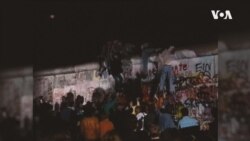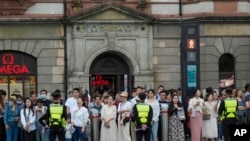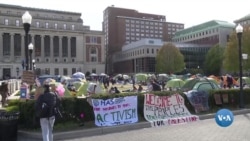ເດືອນພະຈິກ ເປັນຂີດໝາຍ 30 ປີນັບຕັ້ງແຕ່ກຳແພງ ເບີລິນ ໄດ້ພັງລົງ. ການພັງລົງຂອງກຳແພງດັ່ງກ່າວ ໄດ້ເຮັດໃຫ້ການແບ່ງແຍກກັນ ໃນນະຄອນຫຼວງ ເບີລິນ ສິ້ນສຸດລົງ ແລະ ເປັນສັນຍາລັກຂອງການບົດປ່ອຍ ເຢຍຣະມັນ ຕາເວັນອອກໃນທີ່ສຸດ, ແລະ ຕໍ່ມາໃນທົ່ວ ຢູໂຣບ ຕາເວັນອອກ ນັ້ນ, ອອກຈາກການປົກຄອງຄອມມິວນິສ ໂຊວຽດ. ແຕ່ດັ່ງທີ່ນັກຂ່າວວີໂອເອ ຊາລສ໌ ເມນສ໌ ລາຍງານນັ້ນ, ໃນຂະນະທີ່ກຳແພງໄດ້ພັງໄປດົນແລ້ວ, ມັນກໍຍັງເປັນເງົາມືດທີ່ປົກຄຸມຊີວິດຂອງປະຊາຊົນ ເຢຍຣະມັນ ຢູ່. ເຊິ່ງ ພຸດທະສອນ ຈະນຳລາຍລະອຽດມາສະເໜີທ່ານໃນອັນດັບຕໍ່ໄປ.
ຊ່ວງເວລາດັ່ງກ່າວຍັງຄົງເປັນເວລາທີ່ເຈັບປວດທີ່ສຸດ ແລະ ເຕັມໄປດ້ວຍຄວາມຫວັງຂອງສັດຕະວັດທີ 20.
ໃນໂທລະພາບ, ຮູບພາບຕ່າງໆແມ່ນໄດ້ເປັນແຮງບັນດານໃຈໃຫ້ໂລກ. ໃນນະຄອນຫຼວງ ເບີລິນ, ຄ່ຳຄືນດັ່ງກ່າວແມ່ນໄດ້ປ່ຽນແປງຊີວິດຂອງຜູ້ຄົນ.
ທ່ານ ຟລໍຣຽນ ສມິດ, ຜູ້ອາໄສຢູ່ນະຄອນຫຼວງ ເບີລິນ ໄດ້ກ່າວວ່າ “ຫຼາຍຄົນໄດ້ມາຈາກພາກຕາເວັນອອກຫາຕາເວັນຕົກ ແລະ ພວກເຮົາໄດ້ຍ່າງສວນທາງກັນ. ແລະ ມັນກໍມີເສັ້ນສີຂາວນີ້.”
ທ່ານ ຟລໍຣຽນ ສມິດ ຕອນນັ້ນແມ່ນນັກສຶກສາໃນ ເບີລິນ ຕາເວັນຕົກ. ລາວແມ່ນນຶ່ງໃນນັກສຶກສາ ເຢຍຣະມັນ ຫຼາຍພັນຄົນ ທີ່ໄດ້ຂຶ້ນໄປເທິງກຳແພງໃນຄືນນັ້ນ ຊຶ່ງນຳໄປສູ່ ຢູໂຣບ ໃໝ່. ເກືອບວ່າໂດຍບັງເອີນ.
ທ່ານ ຟລໍຣຽນ ເວົ້າວ່າ “ສຳລັບຂ້າພະເຈົ້າເວລານີ້ມັນມັນແມ່ນຄວາມຕື່ນເຕັ້ນ ແລະ ອັນຕະລາຍ ແລະ ຫຼັງຈາກເຈົ້າຮູ້ແທ້ໆວ່າ ຊ່ວງເວລານີ້ມັນສຳຄັນຫຼາຍຊ່ຳໃດໃນປະຫວັດສາດ. ບໍ່ມີຫຍັງໄດ້ເປັນຄືເກົ່າອີກ.”
30 ປີຕໍ່ມາ, ເຈົ້າມີແຕ່ສາມາດຍ່າງກັບໄປກັບມາ.
ຊາກຂອງກຳແພງທີ່ກະຈາຍໄປທົ່ວນີ້ຍັງໄດ້ຕັ້ງຢູ່ໃນຕົວເມືອງ, ຈົນກໍ່ໃຫ້ເກີດມີຄຳຖາມຈາກນັກທ່ອງທ່ຽວຂຶ້ນມາໃນທັນທີວ່າ “ນີ້ແມ່ນຕາເວັນອອກ ຫຼື ນີ້ແມ່ນຕາເວັນຕົກ?
ແຕ່ວ່າເລື່ອງຍັງຄົງເປັນແຮງບັນດານໃຈ ເຊັ່ນດຽວກັບອະນຸສອນສະຖານ ລະນຶກເຖິງການປະຕິວັດທີ່ສະຫງົບຂອງ ເຢຍຣະມັນ ແລະ ຊີວິດທີ່ໄດ້ສູນເສຍໄປຢ່າງບໍ່ມີຄວາມຮູ້ສຶກກ່ອນທີ່ເຂົາເຈົ້າໄດ້ມາຮອດ.
ຜູ້ຊາຍຢູ່ຖະໜົນຄົນນຶ່ງໄດ້ກ່າວວ່າ “ຂ້າພະເຈົ້າຄິດວ່າມັນແມ່ນບ່ອນທີ່ສະຫງົບທີ່ເປັນຕາຢູ່, ເມື່ອເຈົ້າມາທີ່ນີ້. ແຕ່ນີ້ມັກຈະເປັນສິ່ງເຕືອນໃຈ ກ່ຽວກັບ ສິ່ງທີ່ໄດ້ເກີດຂຶ້ນ. ຫວັງວ່າມັນຈະບໍ່ເກີດຂຶ້ນອີກ.”
ດ້ານມືດຂອງຊີວິດໃນ ເຢຍຣະມັນ ຕາເວັນອອກທີ່ປົກຄອງໂດຍພັກຄອມມູນິສ ທີ່ເອີ້ນວ່າ “ສາທາລະນະລັດ ປະຊາທິປະໄຕ ຫຼື GDR ແມ່ນບໍ່ໄດ້ຖືກຫຼົງລືມ.
ຫໍພິພິຕະພັນ ສຕາຊີ ຂອງ ເຢຍຣະມັນ ໄດ້ບັນທຶນການລ່ວງລະເມີດຂອງຕຳ ຫຼວດລັບ ເຢຍຣະມັນ ຕາເວັນອອກ ທີ່ຄັ້ງນຶ່ງເຄີຍເປັນຕາຢ້ານ.
ນາງ ແອນເນກາ ຜູ້ຢ້ຽມຢາມຫໍພິພິຕະພັນ ເວົ້າວ່າ “ແມ່ນແລ້ວ, ເຈົ້າມັກຈະມີຄວາມຮູ້ສຶກທີ່ວ່າເຂົາເຈົ້າກຳລັງເບິ່ງເຈົ້າຢູ່. ສະນັ້ນມັນແມ່ນເປັນລະບອບການປົກຄອງທີ່ກົດຂີ່ຂູດຮີດຫຼາຍ.”
ແຕ່ວ່າ, ດ້ວຍເວລາ, ເອີ້ນມັນວ່າ ໂຣກຄິດຮອດບ້ານ, ເອີ້ນມັນວ່າ ຄວາມຢາກຮູ້ຢາກເຫັນ ມັນຍັງໄດ້ມີຄວາມສົນໃຈເພີ່ມຂຶ້ນ ໃນຄວາມຮູ້ສຶກທີ່ໄດ້ອາໄສຢູ່ໃນນັ້ນແທ້.
ໃນຫໍພິພິຕະພັນ GDR, ຜູ້ທ່ຽວຊົມສາມາດລອງຂັບລົດຍີ່ຫ້ໍ ທຣາບັ້ນ ທີ່ມີຢູ່ທົ່ວທຸກແຫ່ງຂອງ ເຢຍຣະມັນ ຕາເວັນອອກ. ລອງປະສົບການໃຊ້ຊີວິດໃນເຮືອນຫ້ອງແຖວລະບອບ ຄອມມູນິສ ຫຼື ຫົວຂວັນແງ່ມຸມທີ່ແປກໆຂອງຊີວິດລະບອບ ຄອມມູນິສ.
ນາງ ແວເນັສຊາ ເລັມເຄີ ເວົ້າວ່າ “ນອກຈາກດ້ານທີ່ຮ້າຍແຮງ ແລະ ເປັນແງ່ລົບ ຂອງຜະເດັດການສັງຄົມນິຍົມທັງໝົດນີ້, ມັນກໍມີຊີວິດທີ່ປົກກະຕິຢູ່. ແລະ ປະຊາຊົນກໍລຶ້ງເຄີຍກັບການອາໄສຢູ່ໃນລັດນັ້ນ. ແລະ ເຂົາເຈົ້າກໍໄດ້ມີຊີວິດທີ່ດີ ແລະ ບໍ່ໄດ້ປະເຊີນກັບການຂູດຮິດທຸກວັນ. ນີ້ແມ່ນຄົນກຸ່ມນ້ອຍ ຄົນກຸ່ມນ້ອຍທີ່ສຳຄັນຫຼາຍ ແຕ່ເຈົ້າຕ້ອງໄດ້ບອກເລື່ອງຂອງຄົນສ່ວນຫຼາຍເຊັ່ນກັນ.”
ບັນດາຜູ້ສັງເກດການເວົ້າວ່າ ໃນການຕີຄວາມໝາຍຄວາມຄິດທັງໝົດນີ້ ມັນມີຄວາມຈິງລີ້ຊ່ອນຢູ່. 30 ປີຫຼັງຈາກການພັງລົງຂອງກຳແພງ, ເບີລິນ ແມ່ນມີຄວາມສາມັກຄີກັນ, ແຕ່ ເຢຍຣະມັນ ຕາເວັນອອກ ແລະ ຕາເວັນຕົກ ກໍຍັງຄົງເປັນຄົນແປກໜ້າຢູ່.
ທ່ານ ໂຈເອີກ ຟໍບຣິກ, ຈາກກອງທຶນ ມາຊອລ ເຢຍຣະມັນ ແຫ່ງ ສະຫະລັດ ກ່າວວ່າ “ມັນຍັງຄົງມີອົງປະກອບຂອງຄວາມອັບປະຍົດຢູ່ ເຊິ່ງຊາວ ເຢຍຣະມັນ ຕາເວັນອອກຈຳນວນຫຼວງຫຼາຍ ຖືກປຽບທຽບໃສ່ ຊາວເຢຍຣະມັນຕາເວັນຕົກ ຫຼື ຢູໂຣບກາງ ທຽບໃສ່ ຢູໂຣບຕາເວັນຕົກ ໃນແງ່ທີ່ວ່າ ເຖິງແມ່ນຈະມີຄວາມພະຍາຍາມຢ່າງຫຼວງຫຼາຍທີ່ເຂົາເຈົ້າໄດ້ເຮັດກໍຕາມ, ເຂົາເຈົ້າຍັງຄົງຖືກປະຕິບັດດັ່ງກັບເປັນຄົນ ຢູໂຣບ ຊົນຊັ້ນສອງ ຫຼື ຄົນ ເຢຍຣະມັນ ຊົນຊັ້ນສອງ. ທີ່ວ່າເຂົາເຈົ້າຍັງບໍ່ຄ່ອຍຮອດຈຸດນັ້ນເທື່ອ.”
ການສຳຫຼວດຄວາມຄິດເຫັນໄດ້ຄົ້ນພົບຊາວ ເຢຍຣະມັນ ຫຼາຍກວ່າ ເຄິ່ງນຶ່ງ, 53 ເປີເຊັນ, ເຊື່ອວ່າປະຊາທິປະໄຕຂອງເຂົາເຈົ້າແມ່ນກຳລັງຕົກຢູ່ໃນອັນຕະລາຍ, ເຊິ່ງມີຜົນມາຈາກການລຸກຮື້ຂຶ້ນຂອງລັດທິຊາດນິຍົມ ໃນພາກຕາເວັນອອກຂອງປະເທດ. ແຕ່ຄວາມເຊື່ອຖືຂອງຊາວ ເຢຍຣະມັນ ຕາເວັນອອກ ໃນລັດຖະບານຂອງເຂົາເຈົ້າກໍສັ່ນຄອນເຊັ່ນກັນ, ເຊິ່ງເປັນຜົນສະທ້ອນຂອງຄວາມຈະເລີນຮັ່ງມີດ້ານເສດຖະກິດທີ່ຝືດເຄືອງ.
ທັງໝົດຜູກມັດກັບຊ່ວງເວລານັ້ນໃນປີ 1989 ຫຼັງຈາກການສະເຫຼີມສະຫຼອງ, ການເກັບກວາດ ແມ່ນໄດ້ໃຊ້ເວລາດົນ ແລະ ຍາກ.
ແຕ່ຜູ້ທີ່ຢູ່ໃນເຫດການນັ້ນ, ໄດ້ຍອມຮັບວ່າ ໃນຂະນະທີ່ໄດ້ມີການເຮັດຜິດພາດ, ປະຊາຊົນ ເຢຍຣະມັນ ກໍໄດ້ທຳການຕັດສິນໃຈທີ່ຖືກຕ້ອງຢູ່. ເຊິ່ງໃນທີ່ສຸດ ມັນກໍເປັນທາງເລືອກສຸດທ້າຍ.
ທ່ານ ຟລໍຣຽນ ສມິດ ໄດ້ກ່າວວ່າ “ເມື່ອເຈົ້າຄິດວ່າວ່າ ຢູ່ທີ່ນີ້ມັນເຄີຍເປັນແນວໃດນັ້ນ, ມັນເປັນພຽງບາດກ້າວທີ່ຕ້ອງໄດ້ເກີດຂຶ້ນ. ນັ້ນແມ່ນສິ່ງທີ່ຖືກຕ້ອງ 100 ເປີເຊັນ. ບາງສິ່ງແມ່ນໄດ້ເຮັດຢ່າງບໍ່ຖືກຕ້ອງ ແຕ່ໃນທີ່ສຸດມັນກໍຖືກຕ້ອງ.”
ສາມສິບປີຕໍ່ມາ, ການພັງລົງຂອງກຳແພງ ກໍຍັງເປັນຊ່ວງເວລາທີ່ຕ້ອງໄດ້ສະເຫຼີມສະຫຼອງ ແຕ່ກໍມີໂອກາດທີ່ຈະໃຫ້ເບິ່ງກັບໄປໃນອະດີດ ສຳລັບຜູ້ທີ່ຍັງຖືກມັນຄອບງຳຢູ່.
November marks 30 years since the fall of the Berlin Wall. The Wall's demise brought an end to a dividedBerlin — and symbolized the eventual liberation of East Germany, and later the rest of Eastern Europe, from Soviet communist rule. Yet as Charles Maynes reports, while the Wall is long gone, it still casts a shadow over German life.
The moment remains one of the most searing — and hopeful — moments of the 20th century.
On television, the images inspired the world. In Berlin, the night changed lives.
"Very many people coming from the east to the west..and we were going in the opposite direction. And there was a white line…."
Florian Schmidt was then a student in West Berlin. He was one of the thousands of Germans that charged the wall that night — ushering in a new Europe.Almost by accident.
"For me in this moment it was adrenaline and danger…and the days after you only realized how historic this moment was.//Nothing was the same."
30 years on, you can just…wander back and forth.
Scattered remains of the Wall also snake through the city — prompting the constant question from visitors: is this east or is this west?'
Yet the story still inspires — as does a memorial marking Germany's peaceful revolution…and lives senselessly lost before it arrived.
"I think it's a peaceful lovely place to be, when you come in here. But this is always a reminder of what did happen. Let's hope it never happens again."
The darker side of life in communist East Germany — the so-called German "Democratic" Republic or GDR — has not been forgotten.
Berlin's Stasi Museum' documents the abuses of the once feared east German secret police.
"Yes, you always had the feeling that they were watching you. So it was a very repressive regime."
Yet, with time —call it nostalgia, call it curiosity — there's also growing interest in what it was like to actually live there.
At Berlin's GDR Museum, visitors can test drive an East Germany's ubiquitous clunker the Trabant; experience life in a communist flat, or just laugh at the weirder aspects of communist life.
"Besides all these very serious and negative side of this socialist dictatorship, there was a normal life. And people got used to living in a such a state.And they had good lives and // weren't faced with repressions every day.This was the minority — a very important minority — but you also have to tell the story of the majority."
In these dueling interpretations….say observers….lie a deeper truth: 30 Years after the fall of the Wall', Berlin is unified, but East and West Germany are still strangers.
"There is a still an element of humiliation whereby a lot of a east Germans …vis a vis west Germany…or central Europeans vis a vis western Europe point to the fact that despite the enormous effort they have made, they are still somehow being treated as second class Europeans or second class Germans.That they are still not quite there."
Recent polls find more than half of Germans — 53 percent — believe their democracy is in danger —- a result of rising nationalism in the country's east. Yet, East Germans' faith in their government is also shaken — a reflection of lagging economic prosperity.
It all ties back to that moment in '89 —after the party, the clean up has been long and hard.
Yet those who were there, admit that while mistakes were made, Germans still made the right choice. Ultimately, the only choice.
"When you really think of how it used to be here, it's just a step that had to happen. That was 100% right//// "Some things had been done wrong but in the end it was right."
30 Years on, the fall of The Wall' is still a moment to celebrate…but with room for reflection for those still caught in its shadow.










